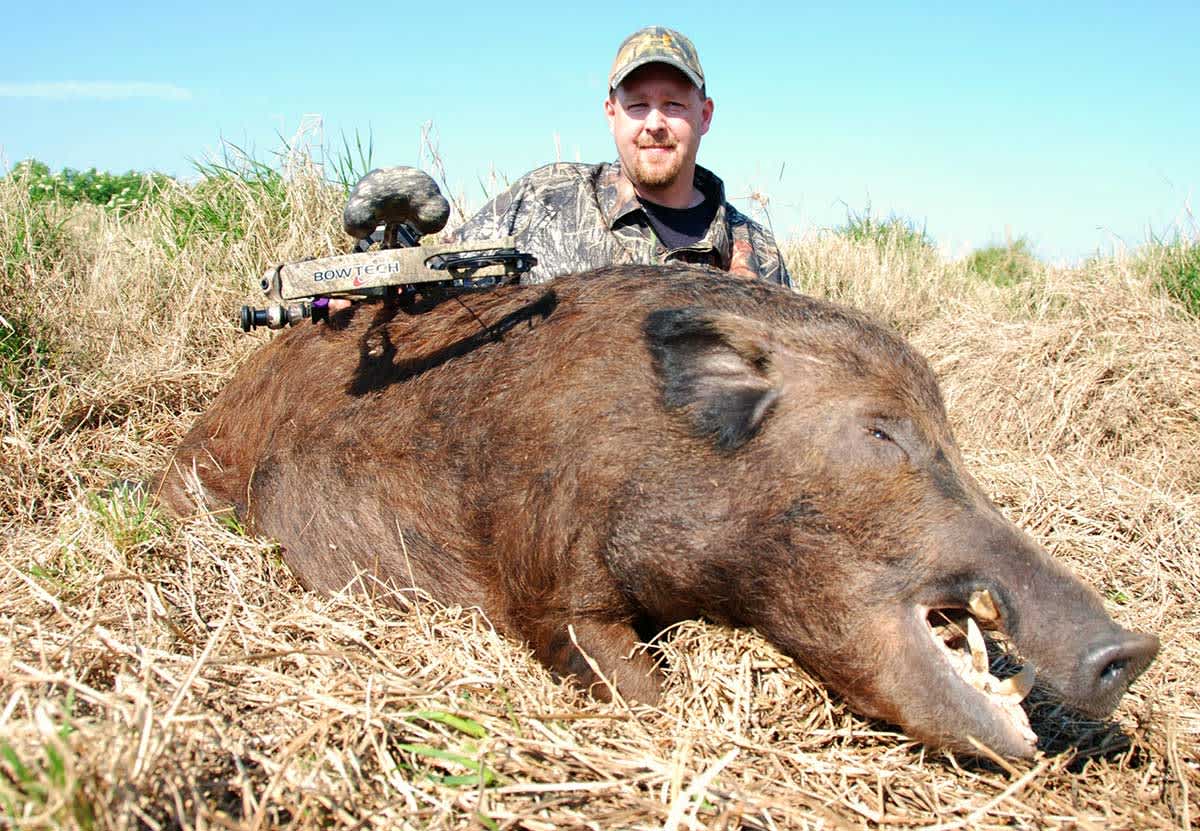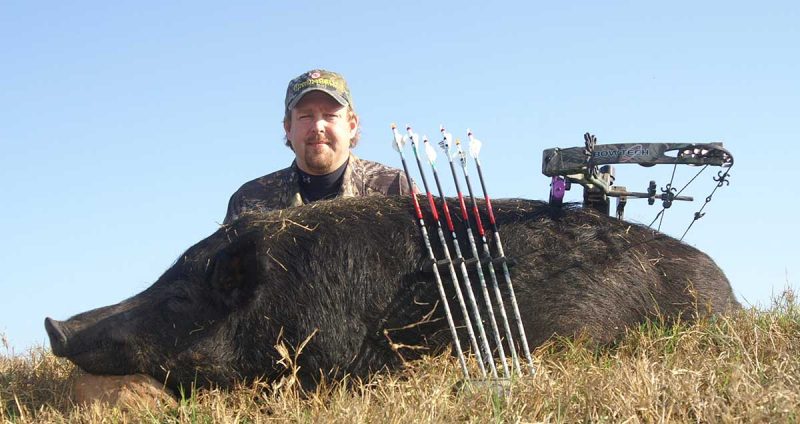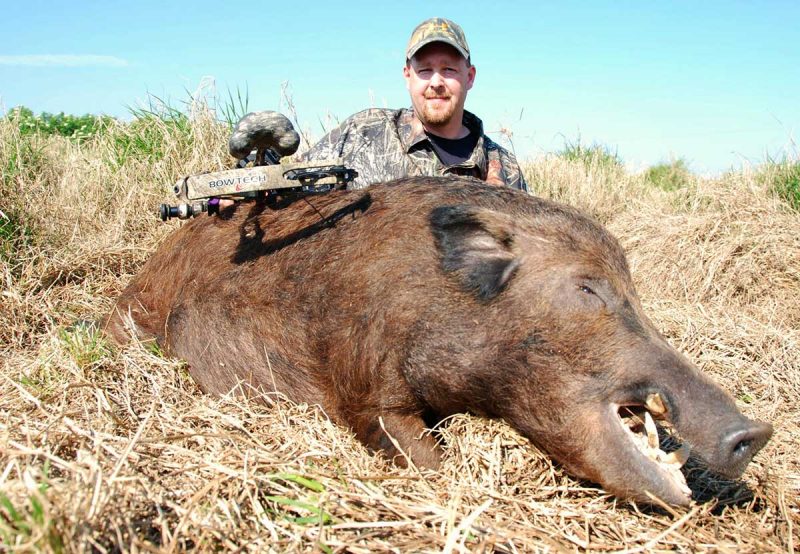Cattle Ranch Boars — The Perfect Year-Round Pursuit
Tim Herald 07.20.17

Wild hogs were seemingly created for the bowhunter. They are prolific, accessible, they don’t have the best eyesight in the world, and they are excellent table fare. Over the past 20 years, I have hunted pigs all over the continental U.S., Hawaii, New Zealand, and in Africa, and without a doubt my favorite places to pursue porkers is on cattle ranches.
In areas where wild hogs are found, cattle operations are great bets for finding huntable populations. The hogs will make raids to steal cattle feed, and they will root up the grazing pastures. Because of their ever-increasing numbers and propensity to cause physical and financial damage to cattle farms, ranchers will often allow hog hunting at little to no cost. This is especially true for bowhunters. Many operations don’t want rifle hunters anywhere near their precious bovines, but they are all too happy to allow archers access.

There are two good ways to pursue hogs on cattle ranches: spot-and-stalk, and stands/blinds. Both methods can be extremely effective, a hunter just needs to use his head and decide which method will work best in each situation.
If you can find exactly where hogs are feeding (very often right from cattle troughs), you can set or build a blind within bow range and wait them out. When they come in to steal dinner, you collect your pork dinner. I find this method works very well for afternoon hunts, where you may arrive before hogs really are on the move, and you can get set and be ready when they come in marauding.
The key to stand hunting hogs is being able to pinpoint where they will be. On operations such as dairy ranches that utilize feed troughs, this is fairly simple to figure out. On free-range beef operations, it can be quite tough. One way to solve the problem is to put out feed to draw in the hogs. In most areas, corn works very well. Many seasoned hog hunters will let their corn “sour” before they put it out so it has a strong smell and is easier for pigs to find. Once you have hogs hitting the feed, it is just a waiting game to get a shot.

My absolute favorite way to hunt hogs is spot-and-stalk. This is best done during the first and last couple hours each day, when temperatures are lower and hogs are on the move. Check out known feeding areas as described above first, and then simply cruise around the property using available cover to stay concealed and try to locate a stalkable hog.
As mentioned previously, hogs don’t have sharp eyesight. If you stand perfectly still or use cover, you usually won’t be detected visually. That said, hogs hear well, and their sense of smell is phenomenal. The wind is the No. 1 factor to be considered when stalking pigs. I use a Bohning wind checker bottle, and I’m constantly keeping tabs on the breeze.
When you get the wind in your favor, take care to be as quiet as possible, and take your time. If you can approach from behind a hog, your chances go up exponentially. You should use any cover or topographic feature possible to mask your stalk, and remember to take your time and not to rush things. You are better off making one slow, high-quality stalk than three hasty stalks that don’t pan out.
One of my favorite places to pursue hogs is a dairy ranch near Okeechobee, Florida, and spot-and-stalk has paid off big there. My hunting buddies and I have shot quite a few porkers, and some have come in thick cover, and some in the wide open.
The two biggest hogs I’ve taken were on very different stalks. Once I spotted two big hogs early in the morning in a wide-open pasture. It was cool, and the hogs were in no hurry to get back to bedding cover. I watched them for a while, and finally they bedded right out in the short grazing pasture. I made a circle to get the wind right, then approached very slowly from behind and to the right of the pair. When I got within 50 yards, I saw there was a small swell in the pasture, so I got on hands and knees and crawled up close. I drew while kneeling and slowly stood up. The hogs were looking away and were a mere 4 yards away. I placed a Carbon Express arrow tipped with a Wac ‘Em broadhead in the middle of the closest hog’s ribcage, and it drove up through both lungs. The 300-pounder went only 25 yards before it flipped head over heels and was out.
Another time, I spotted some pigs in the tall weeds at the edge of a pond between the cattle troughs and a bedding thicket. I moved in, and was just above the hogs with the wind in my favor. I could see bits and pieces of hogs and hear lots of grunting, and then a small pig crossed into the open at 18 yards. The next pig that stepped out was a red monster, and I quickly took aim and released. Although I made a good broadside shot, the big boar ran nearly 150 yards before expiring in head-high brush. I gave him 30 minutes before I followed him up, and he was stiff when I arrived. The huge pig was in the 400-pound class, and is as big as I have ever seen in Florida.

One thing to keep in mind is broadhead placement on hogs. If possible, wait for a quartering-away shot, and whether you get that shot or broadside, aim a bit farther back than you would on deer. Hogs have a thick shield over their shoulders (possibly evolved to protect them while fighting), and you want your arrow to enter behind this plate on its way to the lungs. I have seen arrows go straight into the shield and penetrate only 1 inch, then fall out as soon as the hog ran.
If you have a chance, try some archery hog hunting. Whether you decide to take a leisurely stand or get out and spot-and-stalk, this sport is becoming more popular for a reason — it’s tons of fun. That coupled with the fact it’s generally inexpensive and seasons usually are year-round, make it a perfect big game alternative.
I wish I lived in an area where I could just go out and hunt hogs locally. I would be out there 12 months a year pursuing pork chops, and if you get a taste of it, you will know why — literally and figuratively.
Editor’s note: Tim Herald is an owner and hunt consultant at Worldwide Trophy Adventures (WTA). To book this or any other high-quality hunt anywhere in the world, contact Tim at tim@trophyadventures.com. WTA’s services are free; WTA is paid directly by the outfitter, and your hunt cost is the same whether you book directly with an outfitter or through WTA.

